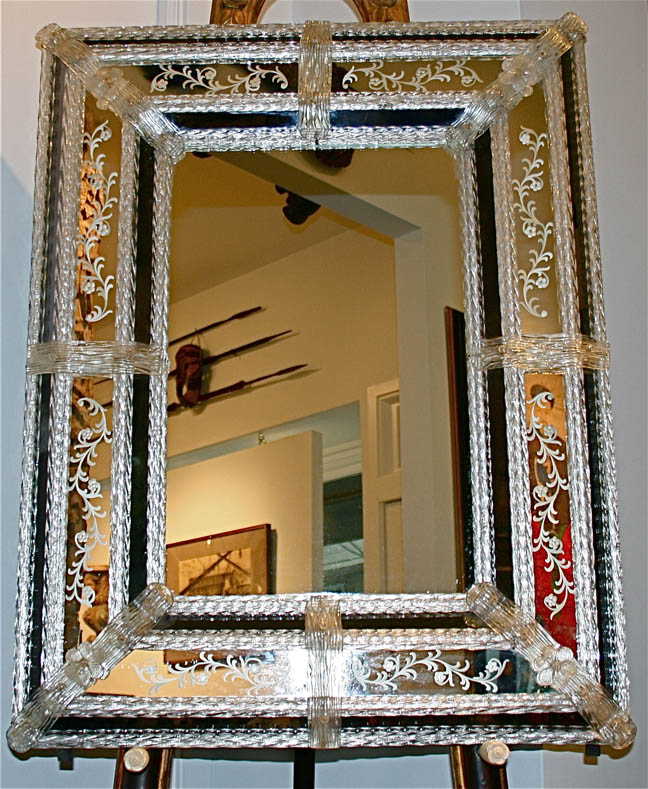

Title: Antique Venetian Hand-Blown Glass Mirror
Shipping: $150.00
Artist: N/A
Period: 20th Century
History: N/A
Origin: N/A
Condition: Museum Quality
Item Date: 1920 to 1930
Item ID: 1797
This Venetian glass mirror is in Excellent Classic Etched Motif, a fabulous design. Italian. A very rare and beautiful mirror, of hand-blown glass, with bevelled floral designs, circa 1920 - 1930. This is a good quality, heavy mirror, solidly constructed. The mirror plate is fine quality, heavy glass (the original), solidly constructed, and in good condition overall, but for a little black specking across the plate and some light fogging. The backing has the traditional wood construction to hold the glass. Lovely, genuine Italian hand-blown glass has been carefully fitted artfully around this frame. Whether you put it in your entry hall, above your mantel, or at the top of the staircase, you will glorify your home.
Link: http://en.wikipedia.org/wiki/Mirror
Mirrors for personal grooming. The first mirrors used by people were most likely pools of dark, still water, or water collected in a primitive vessel of some sort. The earliest manufactured mirrors were pieces of polished stone such as obsidian, a naturally occurring volcanic glass. Examples of obsidian mirrors found in Anatolia (modern-day Turkey) have been dated to around 6000 BC. Polished stone mirrors from central and south America date from around 2000 BC onwards. Mirrors of polished copper were crafted in Mesopotamia from 4000 BC, and in ancient Egypt from around 3000 BC. In China, bronze mirrors were manufactured from around 2000 BC. Metal-coated glass mirrors are said to have been invented in Sidon (modern-day Lebanon) in the first century AD, and glass mirrors backed with gold leaf are mentioned by the Roman author Pliny in his Natural History, written in about 77 AD. The Romans also developed a technique for creating crude mirrors by coating blown glass with molten lead. Reflecting parabolic mirrors were first described by the Arabian physicist, Ibn Sahl, in the 10th century. Ibn al-Haytham discussed concave and convex mirrors in both cylindrical and spherical geometries, carried out a number of experiments with mirrors, and solved the problem of finding the point on a convex mirror at which a ray coming from one point is reflected to another point. By the 11th century, clear glass mirrors were being produced in Moorish Spain. Some time during the early Renaissance, European manufacturers perfected a superior method of coating glass with a tin-mercury amalgam. The exact date and location of the discovery is unknown, but in the 16th century, Venice, a city famed for its glass-making expertise, became a centre of mirror production using this new technique. Glass mirrors from this period were extremely expensive luxuries. The Saint-Gobain factory, founded by royal initiative in France, was an important manufacturer, and Bohemian and German glass, often rather cheaper, was also important. The invention of the silvered-glass mirror is credited to German chemist Justus von Liebig in 1835. His process involved the deposition of a thin layer of metallic silver onto glass through the chemical reduction of silver nitrate. This silvering process was adapted for mass manufacturing and led to the greater availability of affordable mirrors. Nowadays, mirrors are often produced by the vacuum deposition of aluminium (or sometimes silver) directly onto the glass substrate.